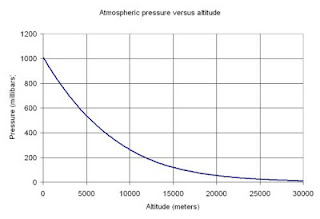Tools
Amongst the myriad of tools a paragliding pilot has at their disposal, few rank higher in importance than those used to assess the ever changing weather picture and forecast soaring conditions. The ability of a pilot to pull in macro weather data and map it against terrain features, thereby generating a micro forecast, can make a huge difference in ease of soaring and XC.We have all heard the recounted exploits of the local 'sky gods' (and goddesses) over a post flying day beer, marvelling at how they always seem to be in the right place at the right time to capture that elusive lift. Much of this is the result of a mental model refined over years of flying experience, but in many cases it is also the result of knowing the right tools to fit with that model. An atmospheric sounding is (potentially) one of those tools.
The Sounding Graph
The sounding graph contains a vast amount of information which a pilot can use to formulate a detailed picture of atmospheric conditions. But before we start delving into what can be gleamed from this graph, we must understand how it is laid out.
Time
The time/date used in the sounding graph is based in Coordinated Universal Time (UTC), which for our purposes is nothing more than the newfangled way of saying Greenwich Mean Time (GMT).
UTC is can be found in a 4 digit format (with the right most pair of digits representing minutes and the remainder representing hours), or a 2 digit one (hours only). The sounding does not resolve to the minute, so a 2 digit time format is used.
The hours in UTC are based upon a 24 hour clock, with 0 representing midnight and 12 (or 1200 in a 4 digit format) representing noon.
During daylight savings time, subtract 7 hours to arrive at local British Columbia Time (PST) from UTC. Otherwise, subtract 8 hours.
The sounding above is for 1500 hrs, May 5, 2013 UTC (8AM PST, May 5, 2013).
Location
Wind
Wind speed and direction are displayed to the right of the graph as a series of altitude dependant barbs.
The spine of the barb is the direction from which the wind is coming. The vanes extending from the spine represent a cumulative sustained speed. Wind speed is measured in knots. A circle with no spine or vanes represents nil/calm/0 knot wind. The blue line vertically traversing the barbs gives a quick indication of wind speed changes versus altitude (with 50 and 100 knot demarcations).
Pressure
The vertical scale along the left side of the graph is the air pressure, measured in hectopascals (hPa). 1000 hPa can be thought of as the air pressure typically found at sea level, while 0 hPa would be perfect vacuum.
Any point found along a line travelling horizontally from the pressure scale is isobaric, the same pressure. This line is frequently referred to as an isobar.
Any point found along a line travelling horizontally from the pressure scale is isobaric, the same pressure. This line is frequently referred to as an isobar.
The pressure value decreases as one ascends through the atmosphere, though it is not a linear relationship with altitude. The relationship is in fact logarithmic in nature - with absolute pressure falling off rapidly at higher altitudes.
1 millibar = 1 hPa.
Opposite to the pressure is the mapping to altitude in feet. The mapping of pressure to altitude will change as weather systems move through a region and create variations in the sea level air pressure.
The pressure component of a sounding is frequently referred to as a Log P.
Temperature
Running across the base of the sounding is the air temperature, measured in degrees Celsius (C). Of note is that fact that the graph lines for temperature do note rise straight upwards as is found in typical X vs. Y graphs, but rise at a roughly 45 degree slope from lower left to upper right. Any point along this 'skewed' line is isothermic, the same temperature. This line is frequently referred to as an isotherm.
The temperature component of a sounding is typically referred to as a Skew-T.
What about the other lines and how can I put this to use?
That my friend, is the topic of the next posting. What sort of blog would this be if it didn't end with a cliff hanger once in a while?









No comments:
Post a Comment